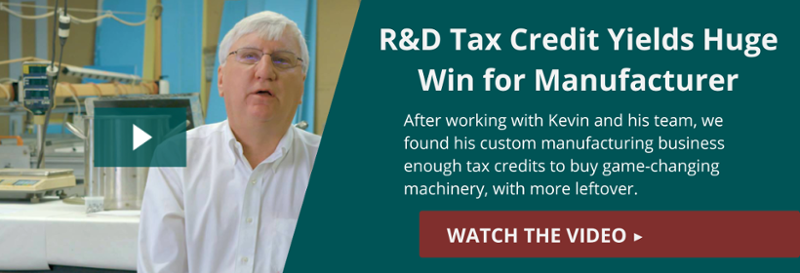
Growing a manufacturing business takes planning, time, and effort. Even then, there are factors that can keep a business from successful growth. With the increase in demand-driven manufacturing, businesses need to be nimble in order to respond quickly to customer needs. Here are four reasons manufacturers aren’t growing due to demand-driven manufacturing and how you can upgrade your business address these problem areas.
1. Expense of investing in new equipment
While it’s often necessary to modernize your production line, purchasing new equipment is a big investment. However, the purchase of new manufacturing equipment can often qualify for the R&D Tax Credit - which can offset some of that investment. There are many activities related to researching, developing, and using the equipment that could qualify as R&D expenses...
For example, one of our clients (a sheet metal fabrication shop) quoted and designed new products, built new tools, improved processes, completed first-time set-up and trial runs, and QC approval process that ultimately netted a $1,300,000 tax credit. They used the credit to purchase a laser, turret, and new press brake to change the way they currently manufacture products. This added more flexibility, reduced waste, and generated more profits.
If a piece of manufacturing equipment is needed in order to yield innovation, it is worth investigating the R&D Tax Credit.
2. High cost of acquiring new customers
The cost of acquiring new customers is always higher than the cost than retaining current customers -- but expanding your reach can be necessary to grow a business. How can you afford to invest in the new equipment and employees needed to work with a new client who may have different requirements?
Look for opportunities to conduct R&D activities that will help you better understand the needs of a new customer or prospect. These sales activities include (but are not limited to):
- Understanding general requirements of the new project
- Evaluating technical specifications
- Approving technical specifications
- Quoting the project
Not only will these activities help you uncover potential innovations and process improvements, they could also qualify for the R&D Tax Credit, giving you the ability to reinvest that money into growing your business.
3. Need for a new facility
If a new facility is needed in order to grow your business, collecting an R&D Tax Credit could be the cash boost you need to fund the expansion. There are several considerations that all manufacturing businesses should take into account when evaluating whether to expand or relocate facilities.
First, it’s important to gain a clear understanding of the pressure your current facility is under and where the bottlenecks and issues are. Is this pressure short-term, or will it continue for the foreseeable future? Knowing this will help guide your facility upgrade. Other aspects such as financial, location and workforce considerations can play a big role as well. Any activities you conduct that will improve upon your current process can qualify for the R&D Tax Credit.
READ: 7 Things to Consider When Your Manufacturing Facility is at Capacity
4. Complications of adding a second shift
Adding a second shift can be an efficient way to expand without drastically increasing the space and equipment needed. It can be an efficient alternative to expanding or building a new facility. With a second shift, orders can be processed and shipped faster and more employees can utilize the same equipment.
A clear understanding of the logistics related to multiple shifts is needed in order to keep things running smoothly. Learnings during planning, analysis, testing, and implementation of a second shift can all lead to process improvements. Activities related to such planning should also be looked at for the R&D Tax Credit.
Taking advantage of the R&D Tax Credit can result in additional cash flow. That money can be reinvested to help your business be more competitive, grow faster, and increase profitability. Specifically, the R&D Tax Credit can be used to help you invest in the people, tools, and processes that will help you grow, despite the emergence of demand-driven manufacturing.
Be sure to consult with an expert to understand how your business can qualify for this tax credit.
Looking for more manufacturing guidance? Check out our Manufacturer's Guide to 2020:
Top 8 Issues Facing the Manufacturing Industry in 2020.





